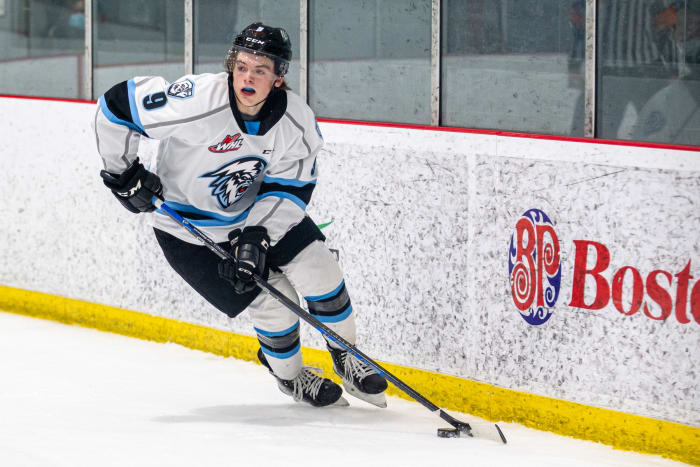With mid-term scouting meetings wrapping up, most teams have some semblance of a list for the 2023 NHL draft.
Maybe it’s 32, maybe it’s 64. Public rankings are becoming more readily available, and fans of teams outside the playoff picture are taking a much closer look at the various prospect websites.
Most rankings are opinion-based. People watch games, whether via video or in person. By now, there is enough of a sample size to build a ranking of who fits where.
I have taken a different approach. While I have scouted and continue to, the focus of this list is not scouting.
Over the course of my education, I researched components of where successful players are drafted from. Those ranged from regions, leagues, point thresholds and other areas that contribute to predicting a player’s value at the NHL level. Not everything made it to the final document, as there were academic standards to be met. However, this research allowed me to build a model that considers a number of factors, weighs them accordingly and provides a ranking of eligible players.
The model does take into account league strength and comparative scoring. A player with 10 points in the SHL in Sweden is likely better than a player with 45 points in the USHL, due to the strength of the league, for example.
The model also has a bust component to it. Players are compared to others who were profiled similarly in their draft years, and if they reach a certain threshold, the model flags the player as having an increased chance of being overvalued and not playing 200 NHL games. If a player in the model has a “Bust” flag, that is weighted accordingly and impacts where the player slots in the overall list.
The model gives a projected tier of players, which is shown. This is not what the player will be at the NHL level. The model uses the comparisons of similar profile players to provide insight into what the player is likely to be at the NHL. There is a sliding scale – so a player noted as “Impact,” will have some comparisons of players that are elite and some that didn’t make it. But, the most common comparisons are to those of “Impact” players.
An explanation of the tiers goes like this: Elite is a top-end NHL player; Connor Bedard’s comparisons would be to those of McDavid, Crosby, players of that ilk. They are very rare. Top Line players are those who are projected to be below the Elite, but among the top 100 forwards in the NHL. Top 6 forwards are those who aren’t expected to be the top players on their team but expected to be offensive contributors and capable of playing Top Line potential if they reach their ceiling.
The same is said for defense. Where it gets cloudy is Impact and Regular. Regular means the player is comfortably projected to play 200 NHL games, which is considered a successful draft pick. Those players are slotted as bottom-six forwards and bottom-pair defensemen who can comfortably play at the NHL level but will hover around the replacement level.
Impact players are those with the widest range of outcomes. Some in this category will be closer to Top 6, while others will be closer to Regular. It is also where the most flags are found. There are players who, if they hit, can be a Top Line/Pair player, but if they don’t, they won’t play in the NHL.
When back-testing the model, some examples of players with volatile projections included Nail Yakupov, Nikita Filatov, Zach Senyshyn, Olli Juolevi, David Pastrnak, Morgan Rielly, Tomas Hertl and Mikko Rantanen. A plethora of examples of first-round selections with Impact projections that hit and those that didn’t exist. That is where scouting and off-ice due diligence are important. It is where the most variance exists and as I strive to improve the model, the area that is the most gray.
Below is the first look at what the model gave me for the NHL draft without adjustment for scouting. It automatically adjusts appropriately for volatility.
As I continue to do research to improve the model, I sought out opinions from a few NHL scouts. The feedback was that it mostly aligned with their general ranges, with a few outliers. The model most certainly favors players who are projected to produce offense in the NHL, which is perhaps why a few players are higher or lower than an NHL scout’s list.
1. Connor Bedard, C, Regina (WHL). Elite tier
2. Adam Fantilli, C, Michigan (NCAA). Top Line
3. Matvei Michkov, RW, Sochi (KHL). Top Line
4. Leo Carlsson, RW, Orebro (SHL). Top Line
5. Will Smith, C, NTDP (USHL). Top 6
6. Zach Benson, C, Winnipeg (WHL). Top 6
7. Andrew Cristall, LW, Kelowna (WHL). Top 6
8. Axel Sandin Pellikka, D, Skelleftea (SHL). Top 6
9. Oliver Moore, C, NTDP (USHL). Top 6
10. Eduard Sale, LW, Kometa Brno (Cze.). Top 6
11. Colby Barlow, LW, Owen Sound (OHL). Top 6
12. Brayden Yager, C, Moose Jaw (WHL). Top 6
13. Ryan Leonard, RW, NTDP (USHL). Top 6
14. Dalibor Dvorsky, C, AIK (Swe.). Top 6
15. Riley Heidt, C, Prince George (WHL). Impact
16. Matthew Wood, RW, UConn (NCAA). Impact
17. Dmitri Simashev, D, Loko-76 (Rus.). Impact
18. Gabe Perreault, LW, NTDP (USHL). Impact
19. Noah Dower-Nilsson, C, Frolunda (Swe.). Impact
20. Koehn Ziemmer, RW, Prince George (WHL). Impact
21. David Reinbacher, D, Kloten (Swi.). Top 4
22. Lukas Dragicevic, D, Tri-City (WHL). Top 4
23. Samuel Honzek, LW, Vancouver (WHL). Impact
24. Nate Danielson, C, Brandon (WHL). Impact
25. Cal Ritchie, C, Oshawa (OHL). Regular
26. Jayden Perron, RW, Chicago (USHL). Impact
27. Mikhail Gulyayev, D, Omsk (Rus.). Top 4
28. Cameron Allen, D, Guelph (OHL). Regular
29. Quentin Musty, LW, Sudbury (OHL). Impact
30. Oliver Bonk, D, London (OHL). Regular
31. Gavin Brindley, RW, Michigan (NCAA). Impact
32. Ethan Gauthier, C, Sherbrooke (QMJHL). Impact
.
